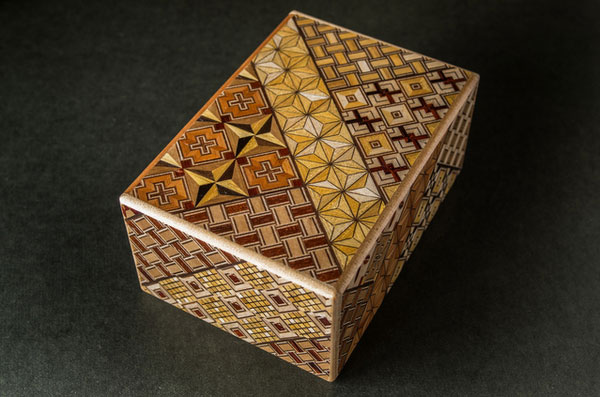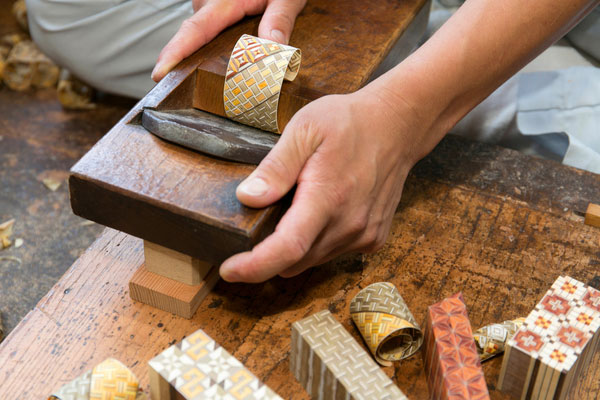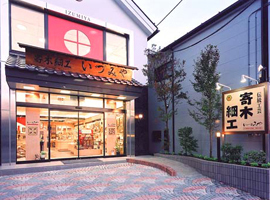
- Wood, bamboo crafts
- Kanagawa
Hakone wood mosaic Hakone yosegi zaiku
Made of trees from Mt. Hakone
An endless array of charming geometric mosaics
Description
What is Hakone wood mosaic ?
Hakone yosegi zaiku is a form of marquetry produced in the town of Hakone, Kanagawa prefecture, an area renowned for having the most natural environment in Japan. For this reason, there is a rich variety of tree species found on Mt. Hakone. Such abundant raw materials allow craftsmen to make the best use of a wide variety of wood colors and create a large range of eye-catching patterns. Traditional motifs found in other craftwork such as kimono or washi (Japanese paper) also appear in the Hakone yosegi zaiku pattern book and include iconic designs like geometric key or hemp-leaf patterns and fletched arrow or ocean wave patterns. The patterns are exquisitely expressed with over fifty tree species and a stunning range of wood.
Originally, this handicraft was produced as souvenirs sold on the Tokaido Highway*, and the very earliest pieces show clear evidence of their high craftsmanship. In 1984, this form of marquetry was designated as a traditional craft by the Minister of International Trade and Industry, going from roadside souvenir item to an esteemed, intricate artwork.
*The Tokaido Highway linked Kyoto to Edo (old name of Tokyo) during the feudal Edo period (1603-1868). Hakone was an important checkpoint used to control the traffic on this highway.
History
Marquetry already existed around the early years of the Heian period (794-1185) in the form of high-quality furniture and furnishings. However, early prototypes of Hakone yosegi zaiku did not exist until later in the Edo period (1603-1868), when the founder Nihei ISHIKAWA, living in Hatajuku, Hakone, made basic items often from one type of wood or with simple surface drawn patterns. In those days, the glorious array of colors was still to come, but even so the plain wooden items produced as souvenirs sold at tea shops or hot spring resorts littered along the Tokaido Highway, were much appreciated by the ordinary people. By the end of the Edo period, many hikimono (lathe-turned) and sashimono (cabinetwork) pieces were being produced. Then the marquetry artistry flowered with designs that incorporated intricate and delicate patterns, drawing upon the rich variety of tree types. These designs are still often seen today. With the addition of wooden toys and other crafts, Hakone yosegi zaiku soon spread throughout Japan as a woodcraft loved by the ordinary people.
General Production Process

- 1. Drying
Firstly, timber is cut and left to dry in the shade.
- 2. Selecting materials
The types of wood are divided by colors. Some key species of wood are holly, chestnut, rengas, and magnolia and the most popular wood colors are white, black, brown, and green respectively. Other types of wood have shades of gray, yellow, and red.
A key aspect of marquetry is to select wood colors that match each design. There are numerous kinds of patterns. The basic ones are squares, octagons, three nested boxes, geometric hemp-leaves, fletched arrows, ocean waves, checks, keys, and basket weaves. In modern times, not only have the traditional patterns been passed down the generations, but new designs are also slowly being introduced.
- 3. Trimming wood pieces
A kanna or Japanese hand plane is used to shave down selected rough wooden tiles to the desired thickness. Then, glue is applied to the wood pieces before stacking them in the order of the pattern color scheme and crimping together. This becomes the base marquetry material.
- 4. Planing
The next stage is to cut workpieces from the base material. The base material is shaved to an angle of 45 degrees. Then it is fitted into a cutting guide to be cut by a handsaw. Lastly it is shaved more accurately with a hand plane.
- 5. Marquetry
Based on the pattern, cut pieces with the same shape are combined, glued together, and tied with a cotton cord. This marks the completion of the patterned unit section. The meticulous production of the patterned unit piece allows the finished work to be so beautifully detailed.
- 6. Uniform thickness
By repeating the gluing of patterned unit pieces, larger patterns can be created. The larger piece is again tied with cord and hand sawn to a prescribed thickness in order to produce many blocks. Then these blocks are joined together to create a structural pattern creating a yosegi taneita.
- 7. Shaving to paper thin sheets
Yosegi taneita are shaved with a large hand plane into many paper thin sheets, rather like a very thin veneer and are known as zuku.
- 8. Processing paper thin sheets
The often curled paper thin sheets are ironed to flatten, or lined using Japanese paper to help stretch them.
- 9. Gluing
In the final stage, paper thin sheets are carefully glued on the surface of an item such as a small box. The thin sheets are used in much the same way as a very thin wood veneer. For solid marquetry wood products, the wooden block yosegi taneita will be used. Marquetry production involves repeatedly gluing different types of wood. By building and expanding the basic small pattern, stunning and elaborate designs are created, which requires a high degree of precision and painstaking patience.
Leading Ateliers
Hakone wood mosaic Izumiya

We create articles of rare beauty to make sure that our customers can enjoy the best Hakone wood mosaic items for a very long time.
-
ClosedThursdays
-
DirectorEisaku NAKAZATO
-
Business Hours10am to 4pm
-
Address
-
Tel.+81-460-83-6030
Where to Buy & More Information
Hatajuku Yosegi Hall
-
Address
-
Tel.+81-460-85-8170
-
ClosedMondays and around the New Year
-
Business Hours9:30am to 4pm
-
Website
See more Wood, bamboo crafts
- Hakone wood mosaic
- Iwayado traditional chest
- Kaba cherrybark woodcrafts
- Odate bentwood
- Inami wood carvings
- Matsumoto furniture
- Beppu bamboo crafts
- Edo wood joinery
- Ichii woodcarvings
- Suruga bamboo crafts
- Edo bamboo fishing rods
- Kishu bamboo fishing rods
- Kamo traditional chest
- Kyo wood joinery
- Miyakonojo archery bows
- Osaka carved wooden panel
- Miyajima woodwork
- Nibutani carved wooden tray
- Okuaizu Basketry
- Echizen traditional chest
- Kasukabe traditional paulownia chest
- Katsuyama bamboo crafts
- Osaka karaki wood joinery
- Takayama tea whisks
- Toyooka wicker crafts
- Akita cedar tubs and barrels
- Nagiso woodturning
- Kishu traditional chest
- Nagoya traditional paulownia chest
- Osaka bamboo screens
- Osaka-senshu traditional paulownia chest
- Sendai traditional chest































































































































































































































































































